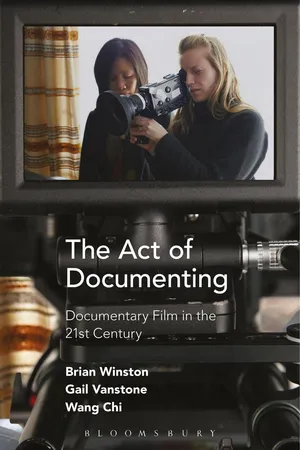![]()
PART 1
Digital Potentials
The definition of documentary has always been prone to technological determinism. The introduction of the analog film camera itself, sound, 16mm synch sound, and analog video have conventionally marked the stages of documentary’s history. Now, at the crossroads of the twenty-first century, such a technicist proclivity persists, again claiming the apparatus as documentary’s prime determinant:
new silicon-based technology is transforming documentary expression and nonfiction media, allowing for a full spectrum of possibilities. Our brave, new and complicated world is filled with change and choice.
(Wintonick, 2013: 376)
The documentary tradition hitherto has rested on three elements all of which are potentially transformed by the digital: the scientistic authenticity of photographic IMAGE it presented (Chapter 1); the eurocentrically determined means of production, the KIT needed to make it (Chapter 2); and the dominate patriarchal tone of the STORY it told about the world (Chapter 3). The new technology affects all three; but to what effect?
![]()
1 “A Walk in the Woods”
IMAGE: The concept of the documentary is grounded in an assumption about the AUTHENTICITY (1) of the photographic image as determined by an audience Indexing (1.1) it as such. The given is that the image is Evidence (1.2) that can be so tested. Yet, this still requires a measure of TRUST (2). Manipulation (2.1) has always been possible. The audience is obliged to exercise Judgment (2.2). The spectator must deploy a certain SAVVY (3) when drawing Inferences (3.1) from, and assessing the Probability (3.2) of, documentary truth.
1. AUTHENTICITY
1.1. Indexing
A “Lazarus Taxon” is a long extinct biotic group unexpectedly discovered to be still extant (Bottjer, 2003: 203). In 1938, 99 years after its fossil had been identified by Louis Agassiz and dated as extinct in the Late Cretaceous 66 million years ago, a living coelacanth was fished up from the waters off the Eastern Cape of South Africa. Agassiz also identified in the fossil record the megalodon, a giant species of shark some 20 meters or more in length, thought to be extinct since the end of the Pliocene 2.6 million years ago (Gottfried et al, 1996: 55–66). In 2013, many thousands of kilometers to the west of the site of the coelacanth recovery, evidence of a living megalodon, another “Lazarus” was uncovered and presented to the public on August 4, 2013 in a Discovery Channel documentary: Megalodon: The Monster Shark Lives. It was the opening salvo of “television’s longest running must-see summer tv event”: “Shark Week.”1
According to Noel Carroll “we typically ‘index’ a film as either fiction or non-fiction” (Carroll, 1983; 1996). This
particular indexing of a film mobilizes expectations and activities on the part of a viewer. A film indexed as non-fiction [eg a documentary] leads the spectator to expect a discourse that makes assertions or implications about actuality” (Plantinga, 1996: 310).
An indexing “savvy spectator,” though, will not rely on the image alone to test such claims (Plantinga, 1996: 324). Its context too will be in play; how it is presented to them in the first instance—in effect, how it is marketed. Megalodon: The Monster Shark Lives is thus prima facie a documentary not least because it was on The Discovery Channel. That alone means assertions or implications about actuality are in play as the channel was established in 1985, by John Hendricks, exactly to be “devoted to documentaries” (Hendricks, 2013: 3). Hendricks’ shared John Grierson’s vision of documentary as a tool of public enlightenment. Initially at least, The Discovery Channel’s entire marketing thrust was educational. It was a decidedly up-market addition to the US cable industry’s offer. Carroll’s concept of “indexing” thus allows for Megalodon: The Monster Shark Lives to be received as a documentary “ahead of time” of viewing (Carroll, 1996: 287).
Moreover, the “savvy spectator” of Megalodon: The Monster Shark Lives might also be expected to know of the coelacanth—a number now having been fished up. This knowledge, it could be argued, “mobilizes expectations and activities” on their part, prima facie, to accept the possibility of a prehistoric survivor—a fish in remote waters, say, as a big as a “submarine”—and to trust the photographic evidence of it. The film deploys all the protocols of documentary. It has experts, forensically deconstructed images, detailed maps, found amateur footage, witnesses carefully labeled to be credible. It cites the odd independently verifiable event, eg a controversial Western Australian shark cull which actually took place; and it references the impact of global warming on animal behavior patterns. There is even end-title authentication:
None of the institutions or agencies that appear in the film is affiliated with it in anyway, nor have they approved its contents. Though certain events and characters in this film have been dramatized, sightings of “submarine” have continued. Legends of great sharks persist all over the world. There is still debate about what they may be. Produced by Pilgrim Studios for Discovery Chanel MMXIII. Discovery Channel LLC.
“What you are witnessing are the actual events as they unfolded,” stated an initial voice-over. “These images were filmed by a Discovery Channel crew. Viewer discretion is advised.”
That “advice,” it might be thought, is an alert at the film’s outset that viewers’ cynicism might be more required than discretion. The two seconds that the authentication end titles, which actually take 30 seconds to read, were on the screen at the show’s end was another. Its weasel wording, a third. And, overall, so poor were the performances and so obviously doctored virtually all the visual “evidence,” that Megalodon: The Monster Shark Lives was clearly, on its face, a nonsense throughout.
Yet, “savvy spectators,” however savvy, felt duped enough to be aggrieved even by a “documentary” so obviously and crudely faked as Megalodon: The Monster Shark Lives. In this instance, no less savvy a person than the UK Guardian’s influential lead environmental columnist, George Monbiot, was moved to devote a 600-word blog to a serious refutat...
